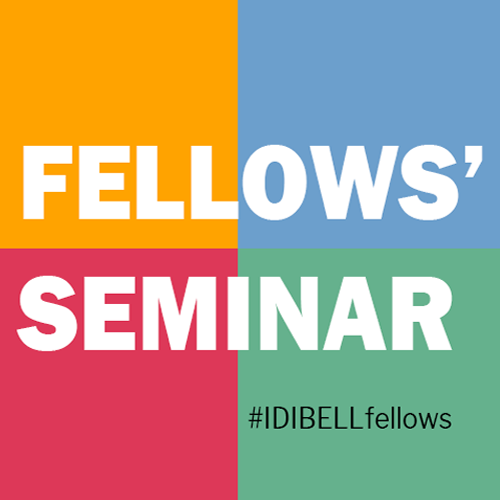
#IDIBELLfellows: Irene Cadenas Jimenez / Carla del Río Torné
29/04/2025
15:00-
McClintock room & online
Resum
Co-culture biofilm patterns among different Pseudomonas aeruginosa clones from cystic fibrosis patients
 Irene Cadenas Jimenez – Epidemiology of bacterial infections
Irene Cadenas Jimenez – Epidemiology of bacterial infections
Pseudomonas aeruginosa, a key pathogen in cystic fibrosis (CF), adapts to the CF lung and uses paranasal sinuses as a reservoir. This study investigated biofilm compatibility between clonal and non-clonal P. aeruginosa strains from the sinuses and lungs of CF patients. Methods: Four strains from three CF patients were analyzed for motility, gentamicin susceptibility, and growth rates. Strains were tagged with fluorescent proteins (YFP/CFP) and co-cultured in flow-cell biofilms. Experiments included: 1) Clonal sinus/lung strains (same patient). 2–3) Mixed lung strains (different clones/patients). 4) Lung strain + reference strain PAO1. Results:Mixed biofilms formed only with clonal strains (same patient). Non-clonal or PAO1 mixtures showed segregated biofilms. Regarding motility, all strains performed swarming was, but twitching was absent in two strains (CF430-142, 75887B); with the latter having a SadB modification that could explain the its low biofilm formation capacity. Conclusion: Biofilm compatibility depends on clonality, suggesting niche adaptation limits cooperation between divergent strains. Twitching motility did not significantly influence biofilm architecture.
Age-Related Differences in Cortical and Subcortical Volumetric Changes in Obsessive-Compulsive Disorder
 Carla del Río Torné – Psychiatry and mental health
Carla del Río Torné – Psychiatry and mental health
Numerous studies have reported that patients with Obsessive-Compulsive Disorder (OCD) exhibit changes in gray matter (GM) volumes across various brain regions, although findings have been heterogeneous. Age has been identified as a crucial factor influencing these structural alterations in OCD. For example, cortical regions such as the prefrontal cortex consistently show reduced volume in OCD patients across all ages, in line with the expected age-related decline in GM volume observed in both OCD patients and healthy controls. In contrast, subcortical structures such as the putamen tend to maintain or even increase their volume with age specifically in individuals with OCD, resulting in comparatively larger GM volumes in older patients. This divergent pattern suggests a complex interaction between OCD and brain aging. In light of these findings, we will present two studies with the aim of identifying the neural correlates underlying GM volume differences in cortical and subcortical areas between OCD patients and healthy controls. To achieve this, we are using neuroimaging analysis, including Voxel-Based Morphometry (VBM), alongside Imaging Transcriptomics techniques to uncover spatial correlations between regional gene expression patterns and brain structural characteristics.
Biografia
